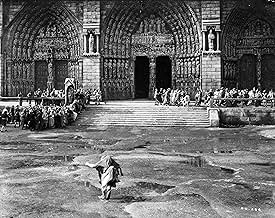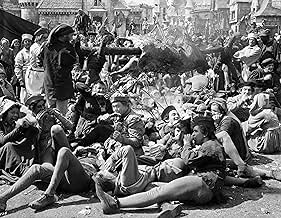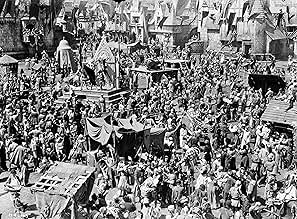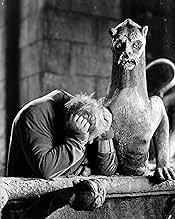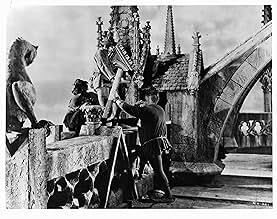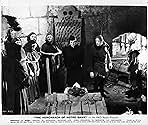VALUTAZIONE IMDb
7,8/10
12.591
LA TUA VALUTAZIONE
Nella Francia del XV secolo, una zingara viene incastrata per omicidio dall'infatuato capo della giustizia e solo il campanaro deforme della cattedrale di Notre Dame può salvarla.Nella Francia del XV secolo, una zingara viene incastrata per omicidio dall'infatuato capo della giustizia e solo il campanaro deforme della cattedrale di Notre Dame può salvarla.Nella Francia del XV secolo, una zingara viene incastrata per omicidio dall'infatuato capo della giustizia e solo il campanaro deforme della cattedrale di Notre Dame può salvarla.
- Candidato a 2 Oscar
- 2 candidature totali
Cedric Hardwicke
- Frollo
- (as Sir Cedric Hardwicke)
Helene Reynolds
- Fleur de Lys
- (as Helene Whitney)
Minna Gombell
- Queen of Beggars
- (as Mina Gombell)
Rod La Rocque
- Phillippe
- (as Rod LaRocque)
Trama
Lo sapevi?
- QuizFor the scene in which Quasimodo is whipped, Charles Laughton instructed an assistant director to twist his ankle outside of camera range so he would really be in pain. Even through the heavy hump and rubber body suit, he felt every lash and often came home badly bruised. Before the 16th take, director William Dieterle whispered to him, "Now, Charles, listen to me. Let's do it one more time, but this time I want you . . . I want you to suffer." According to Laughton's wife, Elsa Lanchester, the actor never forgave him for that.
- BlooperThe cathedral is shown as having a full flight of steps up to the front doors. Notre Dame has always been more or less level with the square (le Parvis).
- Citazioni
[Last lines]
Quasimodo, the bell-ringer: [to one of the stone gargoyles] Why was I not made of stone - like thee?
- Curiosità sui creditiPROLOGUE: "With the end of the 15th Century, the Middle Ages came to a close. Europe began to see great changes. France, ravaged by a hundred years of war, at last found peace. The people under Louis XI felt free to hope again --- to dream of progress. But superstition and prejudice often stood in the way, seeking to crush the adventurous spirit of man."
- Versioni alternativeAlso available in a computer colorized version.
- ConnessioniEdited into The Clock (2010)
- Colonne sonoreAve Maria
(1572) (uncredited)
Music by Tomás Luis de Victoria
Sung by mixed chorus during opening credits
Recensione in evidenza
The ending differs from Hugo's novel,but I guess it was necessary to bestow on the audiences a de rigueur happy end when the world situation was getting worse and worse.It' s also dubious that king Louis XI -who died in 1483- might have been aware of Christophe Colomb's plans ,because the latter only informed the king of Portugal-who refused to put up the money for his expedition- in ...1484!
These are minor squabbles.Because this movie is definitely the finest version of Hugo's classic ,much superior to the French one ,directed by Jean Delannoy(1956) with Anthony Quinn and Gina Lollobrigida.Dieterle's work is a feast for the eyes with numerous classic scenes ,very clever dialogue,superlative performances and complete mastery of the camera.
The opening-Louis XI visiting a printing house-sums up the turning of history:Gutenberg's invention will allow the knowledge and as the King watches the cathedrals ,he makes us feel that these books of stone are fast becoming a thing of the past.The Middle Ages are coming to an end,but a lot of people ,particularly the clergy do not want to lose the power they have on the populace.When Frollo sentences Esmeralda to death,because of his sexual desire,he puts the blame on the devil.He's a man of the past,diametrically opposite to Gringoire,who epitomizes modernity,and who understands the power of the pamphlet which the printing increases tenfold.
Charles Laughton is by far the best Quasimodo that can be seen on a screen:he's so extraordinary that he almost turns the happy end into a tragedy!He gets good support from a moving and extremely beautiful O'Hara as Esmeralda and from Harwicke as Frollo.
Peaks:the fools day,the cour des miracles -maybe showing some influence by Browning's "freaks"-,all the scenes in the cathedral.Dieterle is on par with the most demanding directors all along his movie:the movements in the crowd are stunning,breathtaking,often filmed from the church towers.Humor is not absent either:Gregoire's eventful night in the cour des Miracles is colorful and funny and scary all at once.
A monument,like the cathedral itself.
These are minor squabbles.Because this movie is definitely the finest version of Hugo's classic ,much superior to the French one ,directed by Jean Delannoy(1956) with Anthony Quinn and Gina Lollobrigida.Dieterle's work is a feast for the eyes with numerous classic scenes ,very clever dialogue,superlative performances and complete mastery of the camera.
The opening-Louis XI visiting a printing house-sums up the turning of history:Gutenberg's invention will allow the knowledge and as the King watches the cathedrals ,he makes us feel that these books of stone are fast becoming a thing of the past.The Middle Ages are coming to an end,but a lot of people ,particularly the clergy do not want to lose the power they have on the populace.When Frollo sentences Esmeralda to death,because of his sexual desire,he puts the blame on the devil.He's a man of the past,diametrically opposite to Gringoire,who epitomizes modernity,and who understands the power of the pamphlet which the printing increases tenfold.
Charles Laughton is by far the best Quasimodo that can be seen on a screen:he's so extraordinary that he almost turns the happy end into a tragedy!He gets good support from a moving and extremely beautiful O'Hara as Esmeralda and from Harwicke as Frollo.
Peaks:the fools day,the cour des miracles -maybe showing some influence by Browning's "freaks"-,all the scenes in the cathedral.Dieterle is on par with the most demanding directors all along his movie:the movements in the crowd are stunning,breathtaking,often filmed from the church towers.Humor is not absent either:Gregoire's eventful night in the cour des Miracles is colorful and funny and scary all at once.
A monument,like the cathedral itself.
- dbdumonteil
- 13 giu 2002
- Permalink
I più visti
Accedi per valutare e creare un elenco di titoli salvati per ottenere consigli personalizzati
Dettagli
- Data di uscita
- Paese di origine
- Sito ufficiale
- Lingua
- Celebre anche come
- The Hunchback of Notre Dame
- Luoghi delle riprese
- Azienda produttrice
- Vedi altri crediti dell’azienda su IMDbPro
Botteghino
- Budget
- 1.800.000 USD (previsto)
- Tempo di esecuzione1 ora 56 minuti
- Colore
- Proporzioni
- 1.37 : 1
Contribuisci a questa pagina
Suggerisci una modifica o aggiungi i contenuti mancanti

Divario superiore
By what name was Notre Dame (1939) officially released in India in English?
Rispondi

